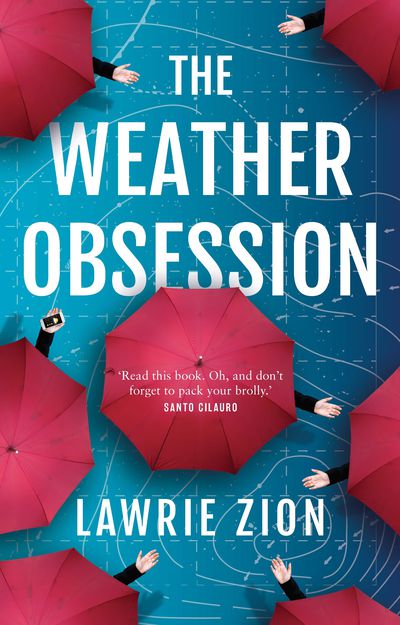←Back to The Weather Obsession

An extract from “The Weather Obsession”
Full disclosure: I am a weather tragic. I have, since the age of five, been completely obsessed with the weather. The trigger, as I recall it, is also one of my earliest memories. I woke up one morning to see my suburban Melbourne street covered in a white blanket that I assumed to be snow. It turned out that there had been a hailstorm, and the ice soon melted. But at that moment I was captivated by nature’s special effects.
As soon as I could read I developed a newspaper habit that began with the weather pages, intrigued by not just the forecasts but also the maps. To the surprise of my family I insisted, at the age of eight, that we get The Australian delivered because it was the only newspaper that featured detailed weather forecasts for all capital cities. I also watched the weather reports at the end of every TV news bulletin, listened to them on the radio and, if home from school, the broadcasts of the rainfall and river heights every day at 12 minutes to two. My idea of a fun day out was a trip with Mum to the Bureau of Meteorology’s Melbourne office, where I would be given photocopies of monthly weather almanacs and climate stats by attentive, if bemused, staff.
It’s quite possible that I was the only nine-year-old who knew how unusual it was for Melbourne to have a 32°C day in the second half of April. Yet what might have seemed like a peculiar hobby turned out to be not so strange. Even author Mark Twain, a critic of the overblown weather clichés that appeared in so many 19th-century novels, conceded back in 1892 that weather is necessary to a narrative of human experience. Here in the 21st century, weather remains a part of our social lubrication, our identity, and it is central to how we live.
‘Weather is ideally suited to the electronic age,’ wrote Bernard Mergen, a professor of American Studies, in his 2008 book Weather Matters. ‘It’s constantly in motion, frequently fast-moving ... ubiquitous and visually beautiful.’
And it’s in this digital age that our interest in the elements is being turbocharged by the growth of weather-related media, especially online. To misquote Prime Minister Turnbull, there has never been a more exciting time to be obsessed with the weather. But how is digital media reflecting and shaping the ways we connect to the weather, and our attempts to accommodate its extremes? Is it fulfilling some innate need, or engaging us in entirely new ways?
The traces we leave on the internet often reveal insights about how and why we engage with the weather. Australians search online for weather more than we search for sex. According to Google, ‘sex’ was a much more popular search term than ‘weather’ in 2004. But by the beginning of 2017, ‘weather’ outstripped ‘sex’ by a ratio of four to one – a trend replicated in several other western countries.
Bureau of Meteorology (BoM) user surveys illustrate in more general (if less graphic) detail the extent to which online is now the go-to destination for weather. In 2005–06, just 39% of us turned to the internet to find weather information – that was less than television (90%), newspapers (65%) and radio (56%). A decade later, the proportion of Australians using the internet to find weather information had more than doubled to 80%.
While more weather information is now produced and packaged by private companies such as Weatherzone, the shift to online is best illustrated by the growing popularity of the Bureau’s website. Launched in 1996, when only around 300,000 Australians were using the internet at home, the site now attracts more than 1.5 billion unique page views a year. That’s an average of two page views a day for the entire population. In January 2017, it was ranked the 20th most-visited site in Australia, and was by far the most popular government site.
The BoM, as so many of us like to call it, is part of our everyday lives, and we like it like that. According to Bureau surveys, 90% of us are satisfied or very satisfied with the accuracy, coverage and timelines of its weather and marine forecasting services. And, of course, there is so much more on the site than the daily forecasts.
For many people, this information is critical to economic success. All up, nearly a quarter of our gross domestic product is weather-sensitive. When farmers check the forecasts or the radar, they aren’t just trying to figure out what to wear; they’re relying on them to make strategic planning decisions. Accurate weather information also means that cyclones don’t strike without warning, and decision-making in the rural, mining and energy sectors is better informed.
But research focusing on how we engage with weather information points to much more than economic utility.
In 2009, 53% of Australians were checking the forecasts daily, and 90% at least once a week. And it’s not just Australians who are obsessed. A 2012 survey conducted in the United States found that weather was the most followed topic of local news, ahead of breaking news, politics and crime. In Britain, where the outdoors is not to be negotiated unprepared, the majority of two thousand adults surveyed by the Met Office (the equivalent of our Bureau) reported that they checked the weather either within an hour of getting up or before leaving the house in the morning. Another finding was that British adults talk about the weather on average six times a week. For women, it is the topic they talk about more frequently than anything else (68%). In fact, Brits talk more regularly about the weather than ‘money (44%), relationships (37%) and even celebrity gossip (15%).’
To what extent do the climates we live in determine our interest in the weather? A team of American researchers, led by Alan E. Stewart, has tried to measure weather ‘salience’ – the level at which we engage with the weather, and how it differs between regions. They found that people in temperate or variable climates are more likely to seek out weather information than people in dry climates. British research also points to changeable weather being a consistent theme of ‘weather talk’.
In Australia, which has as much diversity in its climate as in its population, this might help explain why Melbourne’s notoriously mercurial climate has inspired so much banter, not to mention the classic Crowded House song ‘Four Seasons in One Day’. As cricket journalist Bharat Sundaresan noted in The Indian Express, while covering the 2014–15 Australia v India Test series, ‘You’ll ... hardly find an Aussie who doesn’t have the weather app on his/her smartphone. Melbourne is the clear winner on this front. The city with four weathers in a day obviously has the most number of experts.’
A more (literally) edifying expression of Melbourne’s climate is a new apartment tower in the city’s Docklands precinct which has been designed to respond to the city’s weather conditions. Every night its exterior is illuminated by vertical beams of LEDs that display weather forecasts taken from a monitoring station on the roof of the building that works with data from the Bureau. The artist responsible for the installation, Canadian-born Bruce Ramus, is a lighting designer who wanted to design something that Melburnians could connect with and that hadn’t been done anywhere else. ‘I’ve really been struck, some people call it obsessed, by how occupied people are with the actual weather ... I’ve started to get how the weather patterns really influence how people [in Melbourne] live,’ he said in an interview.
Sydney-based artist and musician Angela Garrick’s ‘Weather Vent’ project delved into how we feel about the weather from another angle. Deploying ‘old media’ technologies that are becoming increasingly obsolete, she placed classified advertisements in regional newspapers around Australia, offering ‘a professional service’ for people to express their frustrations about the weather, and inviting them to leave their contributions on an answering machine. In what proved to be a telling sign of how media consumption habits have changed, she soon noticed the difficulties of attracting responses without resorting to the internet, and duly adjusted her recruitment process.
The feedback was curated into an inventory of whinge and whimsy and presented as an installation at the Cross Arts gallery in Sydney in 2016. As one respondent volunteered, ‘What’s with this weather? I expect at this time of the year to have a cold due to the changing season or hay fever; not because the air conditioning is turned up so high it feels like it should be snowing!’ Another sounded off more succinctly: ‘Hello. I’d like to complain about the weather. It’s absolutely bloody hot right now.’
At a time when the media presents weather in increasingly technological terms, the sheer ordinariness of these deadpan statements provides refreshing illustrations of how we connect to it on a primal level. The responses also illustrate how much of our weather talk can seem repetitive and banal. But Swinburne University psychology professor Greg Murray says that there is nothing inherently trivial about such utterances. Murray, who is an expert in a type of (non-meteorological) depression known as seasonal affective disorder, argues that our interest in the weather is innate and a good thing, and that weather talk is a recognised social dialogue that everyone wants to be a part of.
While much of our weather talk is about what we’re experiencing today, or whether the weekend will be wet or dry, weather events can also loom large in our memories.
Australian historian Tim Sherratt addresses the theme of memory in A Change in the Weather, a collection of essays exploring climate and culture in Australia. Weather is how we experience nature on an everyday basis, he points out. And significant weather events become ‘a matter for comment and concern, as each event is catalogued and compared – the biggest in 50 years, the worst for a generation, perhaps even a turning point in the nation’s progress,’ he says. ‘But while such events stick in our memories, climate and memory never coincide, simply because memory is not an average of the past ... Memory generates meaning, not statistics.’
What will become of our weather memories in the future? Not only do more of us experience what seems to be a growing number of severe weather events, but so many of our reactions to them are recorded in the information and images we share on social media, which has become the new barometer of our engagement with weather in all its forms.
Social media has also become a critical platform for the dissemination of warnings and updates. Twitter, though barely 10 years old, and originally intended for nothing more than ephemeral conversations, has evolved into an archive of much of our mediated lives, including weather events. Type #CycloneYasi, for instance, and you’ll see a rich repository of thousands of tweets, in reverse chronological order, describing the impact of the severe category-five tropical cyclone that devastated coastal communities on the north Queensland coast in February 2011.
While social media is aggregating fascinating accounts of our contemporary weather conversations, Indigenous Australians have adapted to the climate for more than 50,000 years, during which time they developed an understanding of their local climatic patterns. Scholars now believe that their observations of seasonal change ‘have the potential to fill gaps in climate data for tropical northern Australia, and could also serve to inform culturally appropriate adaptation strategies.’
For Europeans who colonised the continent and their descendants, it is a single line from an early 20th-century poem that provides the most discernible narrative thread to what comes closest to a national experience of the weather – the enormous variation in rainfall from year to year. In 1904, when she was just 19 and homesick in London, Dorothea Mackellar wrote ‘My Country’. Its second stanza began:
I love a sunburnt country,
A land of sweeping plains,
Of ragged mountain ranges,
Of droughts and flooding rains.
The last line here has gone on to resonate through Australian culture: it’s the title for a book, an art exhibition, and even a commemorative coin. And that, to use a metaphor that may appear somewhat inappropriate in this context, is just the tip of the iceberg.
This is an extract from Lawrie Zion's book The Weather Obsession.



